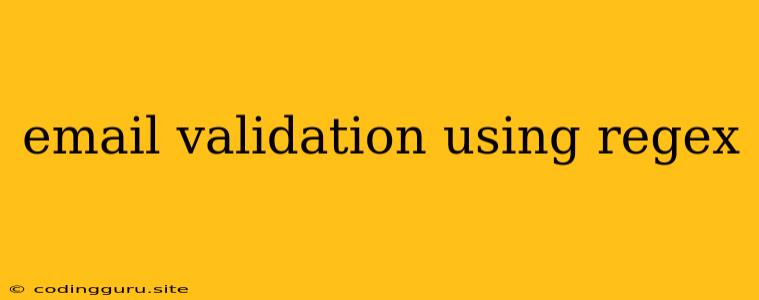Email Validation Using Regex: A Comprehensive Guide
Validating email addresses is a crucial step in web development, ensuring data quality and preventing spam. While various methods exist, using Regular Expressions (Regex) offers a robust and efficient solution. This guide will delve into the intricacies of email validation using Regex, empowering you to implement this vital security measure in your applications.
What is Regex?
Regular expressions are powerful tools for pattern matching in strings. They provide a concise and flexible way to define and search for specific characters, sequences, or structures within text. In the context of email validation, Regex acts as a filter, identifying valid email addresses based on predefined criteria.
Understanding Email Address Structure
Before delving into specific Regex patterns, it's essential to grasp the fundamental structure of an email address. Generally, an email address consists of two primary parts:
- Local part: The part before the "@" symbol, representing the user's unique identifier.
- Domain part: The part after the "@" symbol, specifying the email provider or organization.
For instance, in the email address "[email protected]", "john.doe" is the local part, and "example.com" is the domain part.
Basic Regex Patterns for Email Validation
Let's start with some basic Regex patterns commonly used for email validation:
1. Matching Basic Structure:
^[a-zA-Z0-9._%+-]+@[a-zA-Z0-9.-]+\.[a-zA-Z]{2,}$
This pattern matches the basic structure of an email address, including alphanumeric characters, periods, underscores, percentages, plus and minus signs in the local part, followed by the "@" symbol, then alphanumeric characters, periods and hyphens in the domain part, ending with a top-level domain (TLD) of at least two characters.
2. Specifying Allowed Characters:
^?\.)+?$
This pattern expands upon the previous one by allowing additional special characters like exclamation marks, dollar signs, and ampersands in the local part. It also includes specific rules for the domain part, ensuring it starts with an alphanumeric character and allows for subdomains separated by periods.
3. Incorporating TLD Restrictions:
^[a-zA-Z0-9.!#$%&'*+/=?^_`{|}~-]+@[a-zA-Z0-9-]+(?:\.[a-zA-Z0-9-]+)*\.(?:[a-zA-Z]{2,}|[0-9]{1,3})$
This pattern introduces restrictions on the TLD, allowing for both two-letter domains like ".com" and numerical domains like ".123".
Advanced Considerations
While these basic patterns provide a good starting point, email address formats can be more complex. Here are some advanced considerations:
- Internationalized Domain Names (IDN): Email addresses can contain non-ASCII characters in their domain names. For accurate validation, you might need to use libraries that handle IDN encoding and decoding.
- Usernames with Special Characters: Some email providers allow usernames with special characters outside the commonly allowed ones. You might need to adjust your Regex pattern to accommodate these exceptions.
- Length Restrictions: While most email providers don't explicitly restrict email address lengths, you might consider setting reasonable limits for your application.
Tips for Effective Email Validation
- Test Thoroughly: Use a comprehensive set of test cases, including valid and invalid email addresses, to ensure your Regex pattern accurately validates emails.
- Utilize Online Regex Testers: Tools like Regex101 or Regexr allow you to test your patterns interactively, making it easier to debug and refine them.
- Consider Library Support: Many programming languages and frameworks offer built-in libraries or functions for email validation. These libraries often provide more robust and comprehensive validation rules than custom Regex patterns.
- Document Your Choices: Clearly document the specific validation rules implemented in your code, ensuring maintainability and understanding for future developers.
Conclusion
Email validation using Regex is an essential security measure for web applications. By understanding the structure of email addresses and employing appropriate Regex patterns, you can effectively filter out invalid or malicious entries. Remember to test your patterns thoroughly, utilize online tools for development, and consider leveraging library support for enhanced validation. With these practices in place, you can build robust and secure applications that safeguard user data and enhance overall system integrity.
